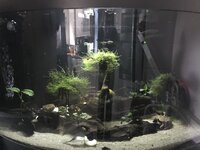scoobiemandan
Member
- Joined
- 29 Apr 2015
- Messages
- 53
Tank - Jewel Trigon 350
Lighting - Jewel Helialux 54W and cheap white LED strip at rear
CO2 - Easylife Liquid Carbon (6ml every day prior to lights on)
Filtration - Fluval 306/1150lph and APS EFX+2000/2000lph
Fertilisation routine - Easylife Profito (30ml weekly after water change)
Maintenance regime - 50% weekly WC, filters cleaned only when flow starts to drop
Only type of Algae I get in the tank is GSA. Covers my Anubias.
I have tried leaving the main Jewel LED light off meaning the cheap white LED bar at the back is the only light source (other than minimal natural daylight, not directly on tank). Removing affected leaves but new growth eventually ends up in the same state. Photo at end to show how low light this is.
Tested Phosphate levels as I'm led to believe that low Phosphate can be a contributing factor in the growth of GSA. 2ppm but I don't know how precise these Api tests are!
Going by pH and kH my CO2 would be around 7ppm, again I understand this is unproven and not very scientific. A drop checker in the tank stays blue so I am assuming CO2 levels aren't sufficient.
Before I go and splash out on CO2 injection I'm wanting to know thoughts on the relationship between Phosphate and GSA. How do I strike a balance with Phosphate when I'm also led to believe high concentrations of Phosphate can lead to outbreaks/blooms of other types of Algae?
I also have an Algae issue with my other tank of a different nature but I'll start a separate thread for that so as not to get to confused here.
Lighting - Jewel Helialux 54W and cheap white LED strip at rear
CO2 - Easylife Liquid Carbon (6ml every day prior to lights on)
Filtration - Fluval 306/1150lph and APS EFX+2000/2000lph
Fertilisation routine - Easylife Profito (30ml weekly after water change)
Maintenance regime - 50% weekly WC, filters cleaned only when flow starts to drop
Only type of Algae I get in the tank is GSA. Covers my Anubias.
I have tried leaving the main Jewel LED light off meaning the cheap white LED bar at the back is the only light source (other than minimal natural daylight, not directly on tank). Removing affected leaves but new growth eventually ends up in the same state. Photo at end to show how low light this is.
Tested Phosphate levels as I'm led to believe that low Phosphate can be a contributing factor in the growth of GSA. 2ppm but I don't know how precise these Api tests are!
Going by pH and kH my CO2 would be around 7ppm, again I understand this is unproven and not very scientific. A drop checker in the tank stays blue so I am assuming CO2 levels aren't sufficient.
Before I go and splash out on CO2 injection I'm wanting to know thoughts on the relationship between Phosphate and GSA. How do I strike a balance with Phosphate when I'm also led to believe high concentrations of Phosphate can lead to outbreaks/blooms of other types of Algae?
I also have an Algae issue with my other tank of a different nature but I'll start a separate thread for that so as not to get to confused here.



